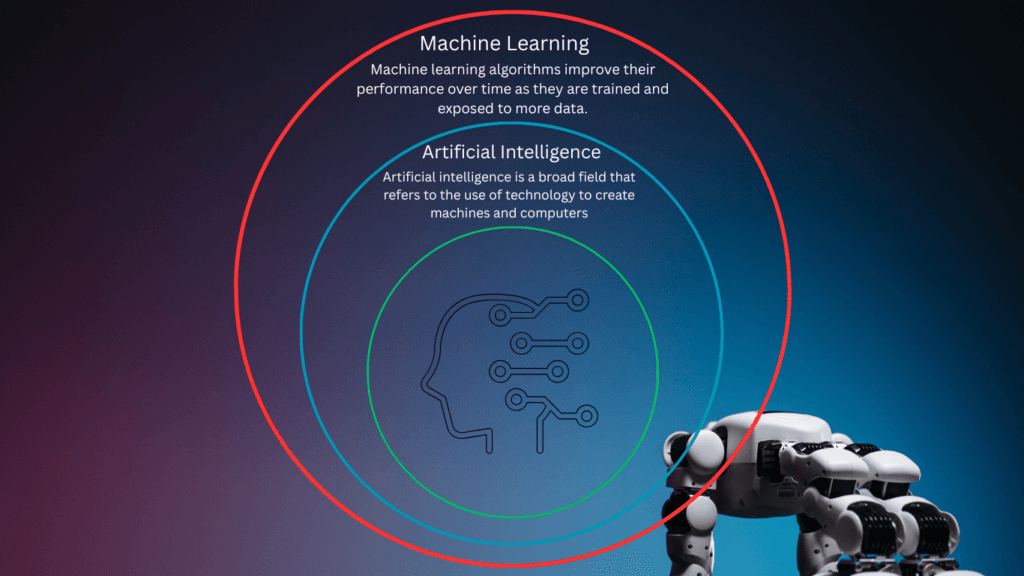You may hear machine learning and artificial intelligence used interchangeably, especially when discussing big data, predictive analytics, and other digital transformation topics. This confusion is understandable, as artificial intelligence and machine learning are closely related. However, these trending technologies differ in many respects, including scope and application.
Machine Learning and artificial intelligence technology are used by businesses to process and analyze large amounts of data, make better decisions, generate recommendations and insights in real-time, and make accurate forecasts and predictions. It is becoming more and more popular.
So what exactly is the difference between ML and AI? How are ML and AI connected, and what do these terms really mean for organizations today?
Let’s break down AI and ML and find out how these two innovative concepts are related and what makes them different from each other.
Machine learning is a tool that allows systems to automatically learn and improve based on experience. Machine learning does not require any special programming to perform activities. Machine learning is the development of computer programs that have access to data and use it through a set of algorithms to learn on their own what actions to take based on that data.
The main objective of machine learning is to enable systems to learn automatically without human intervention. This allows the system to adjust and take action accordingly. The learning process begins with the system observing contextual data and experiences based on that data. The system then begins to understand and learn what actions to take when certain patterns appear in the dataset.
What is artificial intelligence?
Artificial intelligence is a broad field that refers to the use of technology to create machines and computers that have the ability to mimic the cognitive functions associated with human intelligence. For example, you can observe, understand, respond to, and analyze spoken and written language. Collect data, make recommendations, etc.
Although artificial intelligence is often thought of as a system in itself, it is a set of technologies applied to a system to enable it to reason, learn, and act to solve complex problems.
What is machine learning?
Machine learning is a subset of artificial intelligence that allows machines and systems to automatically learn and improve from experience. Instead of explicit programming, machine learning uses algorithms to analyze large amounts of data, learn insights, and make informed decisions.
Machine learning algorithms improve their performance over time as they are trained and exposed to more data. A machine learning model is the output, or what a program learns by running an algorithm on training data. The more data you use, the more accurate your model will be.
How are Machine Learning and Artificial Intelligence connected?
AI and ML are not exactly the same thing, but they are closely related. The easiest way to understand how AI and ML relate to each other is:
- AI is a broad concept that enables machines and systems to understand, reason, act, and adapt like humans.
- ML is an application of AI that enables machines to extract knowledge from data and learn from it autonomously.
One way to help remember the difference between machine learning and artificial intelligence is to imagine them as an umbrella category. Artificial intelligence is a broad term that includes a variety of specific approaches and algorithms. Machine learning falls under that umbrella, but other major subfields such as deep learning, robotics, expert systems, and natural language processing also fall under the same umbrella.
Differences between Machine Learning and Artificial Intelligence

While artificial intelligence involves the concept of machines that can mimic human intelligence, machine learning does not. Machine learning aims to teach machines to perform specific tasks and provide accurate results by identifying patterns.
Let’s say you ask your Google Nest device, “How long will it take you to get to work today?” In this case, you can ask the machine a question and get an answer about the estimated time it will take to drive to the office. The overall goal here is for the device to successfully perform a task, usually a task you would have to perform yourself in a real-world environment (such as figuring out your commute time).
In the context of this example, the purpose of using ML throughout the system is not to be able to perform a task. For example, you can train algorithms that analyze real-time traffic and traffic data to predict the volume and density of traffic flow. However, the scope is limited to learning from data to identify patterns, predict accuracy, and maximize performance for specific tasks.
👉Related Topics:
Artificial Intelligence
- AI allows machines to simulate human intelligence to solve problems
- The goal is to develop intelligent systems that can perform complex tasks.
- Build systems that can solve complex tasks just like humans can
- AI has a wide range of applications
- AI uses technology within systems to mimic human decision-making.
- AI processes all types of data, including structured, semi-structured, and unstructured data.
- AI systems use logic and decision trees to learn, reason, and correct themselves.
Machine Learning
- ML allows machines to learn autonomously from past data
- The goal is to create machines that can learn from data and improve the accuracy of their outputs.
- Use data to train machines to perform specific tasks and provide accurate results.
- The scope of the application of machine learning is limited.
- ML uses self-learning algorithms to generate predictive models
- ML can only use structured and semi-structured data
- ML systems rely on statistical models to learn and can self-correct when provided with new data.
Benefits of using AI and ML together
AI and ML offer powerful benefits to organizations of all shapes and sizes, and new possibilities are constantly emerging. Especially as the amount of data grows in size and complexity, automated, intelligent systems have become essential.
Here are some of the business benefits of using artificial intelligence and machine learning:
- Wide data range
- Analyze and enable a wide range of unstructured and structured data sources.
- Make fast decisions
- Improve data integrity, accelerate data processing, and reduce human error for faster, more informed decisions.
- Capacity
- Improve operational efficiency and reduce costs.
- Analytics integration
- Empower your employees by integrating predictive analytics and insights into your business reports and applications.
Applications of AI and ML
Artificial intelligence and machine learning can be applied in a variety of ways, allowing organizations to automate repetitive or manual processes and make informed decisions.
Companies across different industries are using AI and ML in different ways to change the way they work and do business. By incorporating AI and ML capabilities into their strategies and systems, organizations can rethink how they use data and available resources, improving productivity and efficiency and making data-driven decisions through predictive analytics. Increase take-up and improve the customer and employee experience.
Here are some of the most common applications of AI and ML.
👉Health care and life sciences
Analyze patient health records and gain insights; predict and model outcomes; accelerate drug development; enhance diagnostics; monitor patients; and extract information from clinical notes.
👉Construction industry
Production machinery monitoring, predictive maintenance, IoT analytics, and operational efficiency.
👉E-commerce and retail
Inventory and supply chain optimization, demand forecasting, visual search, personalized offers and experiences, and recommendation engines.
👉Financial operations
Risk assessment and analysis, fraud detection, automated business and service processing optimization.
👉Telecommunication
Intelligent networks and network optimization, predictive maintenance, business process automation, upgrade planning, and capacity forecasting.
Different types of Machine Learning
Machine learning algorithms are divided into 4 primary types.
Supervised machine learning algorithms are the most common. Supervised machine algorithms apply what the system has learned in the past to new data. Supervised algorithms use examples from previous similar training data sets and the faults labeled in them to predict future faults based on new similar data sets being interpreted by the system. Typically, training data sets are first identified through human intervention, and then the system is taught to recognize patterns associated with each applied training data set. The system then compares those training data sets with the newly acquired data set. The system can identify and predict failures of interest when sufficient training data sets are available for comparison. This type of machine learning can compare the tasks it sets with the true intended tasks and identify errors that improve the applied model.
Unsupervised machine learning algorithms use “raw” data that is unclassified and unlabeled. There are no previously identified defects in this raw data, so we are simply attempting to infer functions based on unlabeled hidden defects in the unclassified data. The system does not have predefined failure mode patterns or possible actions, so it cannot determine the appropriate action. Instead, the system examines the data and attempts to draw conclusions based on unknown patterns or labeled faults in the training dataset.
Semi-supervised machine learning algorithms are a combination of both supervised and unsupervised learning that use both labeled and unlabeled datasets for training. These data sets are typically represented as large amounts of unlabeled, unclassified data. The system is then populated with a small, predefined set of labeled and classified failure pattern data. Machine learning systems like the DigivibeMX platform that use this method have significantly improved learning accuracy. Semi-supervised machine learning is chosen when efficient resources are needed to train the acquired labeled data and identify predictive actions to be taken when the system recognizes a failure pattern.Reinforced machine learning algorithms are machine learning methods that perform trial-and-error actions based on a dataset and receive a reward when the correct action is performed. This creates an advanced approach to the decision-making process within the system. This allows the system to quickly and automatically determine the ideal action within a given dataset based on simple reward feedback. This method maximizes system performance through
follow me : Twitter, Facebook, LinkedIn, Instagram


5 thoughts on “Machine Learning vs Artificial Intelligence: The Ultimate Showdown of 2025”
Comments are closed.